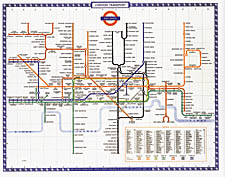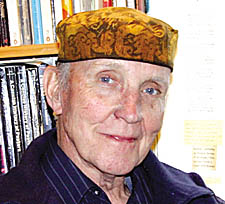
Harry Beck, photographed by Ken Garland

Harry Beck’s Tube map

Ken Garland |
The man behind the map
Harry Beck’s Tube map is
in the top three classic British design icons, writes Dan Carrier.
It’s beautiful, but practical too
Mr Beck’s Underground Map by Ken Garland
Capital Transport, £12.95 Order this book
THE sprawl of the city was proving hard to negotiate for art
student Ken Garland. It was the mid-1950s: he had moved to London
from a small town in Devon and his pangs of homesickness were
made worse by the fact he couldn’t make head nor tail of
how to get about his new home.
But then he discovered Harry Beck.
Training to be a graphic designer, Mr Garland was impressed
with the maps on the walls of Tube stations. Their clarity made
London seem a little less daunting for the undergraduate.
The diagrams, designed by Beck for London Underground, became
a beacon for Mr Garland. It also prompted the trainee graphic
designer to befriend the man behind them – and write a
biography of the designer which last week made a shortlist of
three of the most iconic pieces of British design from the 20th
century.
Mr Garland, 77, lives in Albert Street, Camden Town, recalled
how he had heard Harry Beck was working at the London College
of Printing and so he paid him a lunchtime visit.
He said: “I turned up unannounced and asked around for
him. He was in the canteen and so I introduced myself. He said
pull up as chair and got me a coffee. We became firm friends.”
The BBC poll, which saw over 200,000 people vote over seven
days for the most memorable piece of British design, was eventually
won by Concorde, the recently mothballed supersonic jet.
However, Mr Garland believes the Beck map has touched as many
people.
He added: “The Tube diagram is one of the greatest pieces
of graphic design produced, instantly recognisable and copied
across the world.”
The designer whose own work includes poster art for the St Pancras
Festival and designing board games based on the Tube diagram,
says writing the biography of Mr Beck was a privilege.
He said: “I had a secret admiration for him – I admit
it was a bit of hero worship. His map was groundbreaking –
it was only about connections and not geographical. This meant
he could use only horizontal, vertical and diagonal lines. It
was not to scale – the central area, which was congested
with stops, is enlarged compared to the outlying areas.”
Harry died in 1974, but not before he had told Mr Garland the
story behind the diagram.
Harry Beck was 29 and had been working for the Underground as
engineering draughtsman since 1925, travelling to his Victoria
office from his home in Highgate Village.
He wrote: “I must have lived a very energetic life in those
days. Rarely missed my daily dip in Highgate Pond before breakfast
and I was in the rowing club and the Train, Omnibus and Tram
Staff Philharmonic Society.”
The early 1930s economic crisis saw many plans for the Tube – including a deep, fast-track line that would rush passengers
from north to south, stopping at just the main stations – were mothballed. Beck was laid off.
However, work began to pile up in his old office and because
he had been playing in the transport orchestra his former colleagues
remembered him and, in 1933, he was re-employed.
Before he was first dismissed in 1931, he had been pondering
on the messy nature of the Tube map of the time, which was geographically
correct but hard to navigate.
He told Mr Garland: “Looking at the old map of the railways,
it occurred to me that it might be possible to tidy it up by
straightening the lines, experimenting with diagonals and evening
out the distances between stations.”
His colleagues liked his idea but the publicity department of
the Tube did not. But Beck continued to badger his bosses –
even during the time that he did not officially work for the
Underground – and in 1932 the publicity department changed
their minds. They commissioned a print run of 750,000.
Mr Garland said the initial reaction from Tube users was overwhelmingly
positive. “There were criticisms that the diagram was inaccurate.
But the public loved it,” he said.
Beck constantly updated and improved his map: not least because
the Underground system itself was expanding.
Beck would also add lines that were under construction: one
such incomplete line was a route on the Northern Line linking
Finsbury Park on the Victoria and Piccadilly lines with Highgate.
It would mean Stroud Green and Crouch End getting their own
stations, and Highgate becoming an interchange with an added
line going to stops at Cranley Gardens, Muswell Hill and Alexandra
Palace. His diagram of 1949 boldly shows planned extensions
that, 57 years later, the residents of north London are still
waiting for.
|




